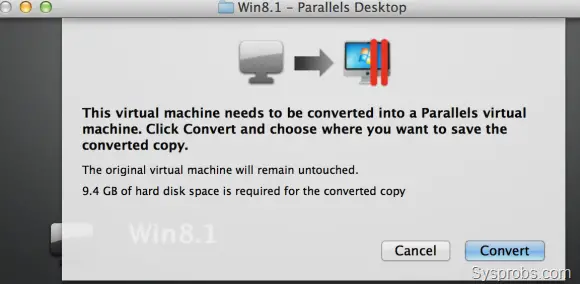- Converting Virtualbox .vdi File To Parallels Workstation 9 For Mac Free
- Converting Virtualbox .vdi File To Parallels Workstation 9 For Macbook Pro
- Converting Virtualbox .vdi File To Parallels Workstation 9 For Mac Os
Guest blog by Padman Krishna, Parallels Support Team
Jul 11, 2019 Parallels Desktop data files end with.pvm. VMware files end with.vm (.vmx for older versions). Virtual PC files end with.vmc. VirtualBox files end with.xml or.vbox. You can also simply drag a Parallels.pvm file to the Parallels Virtual Machines list to add it to Parallels Desktop. Aug 07, 2020 This file will be mounted in your virtual machine later on in the article, so it’s very important that this step is completed successfully. Creating a mac Virtual Machine on Windows. You’ll want to create a virtual machine, and this is really easy. You’ll open up VirtualBox and click New.
Are you looking for a better virtualization experience and planning to switch to Parallels Desktop? Here’s an easy way to transform your existing virtual machine.
There are few things you need to do before converting a VM. First, make sure you have a backup copy of your VM. For example, VMware has a .vmx extension, Virtual PC is .vmc and Virtual Box is .vbox.
Second, make sure you’ve deleted third-party tools from your VM (VirtualBox tools, VMware tools, etc.). If you haven’t done that yet, go to Control Panel → Programsand Features to remove the tools.
Next, make sure that the “Split Disk” option is disabled in your VM hard disk settings. This might sound like another language to some, but no worries – it’s not that hard:
The final thing to do is to shut down the VM completely (suspending or pausing it isn’t enough). Pretty simple, right?
Once all of these steps are completed, you now can convert the VM.

- Open Parallels Desktop and go to File → Open.
- Navigate to the VM file you would like to convert, then click Open.
- Convert the VM by choosing the location where you would like to save the file.
- Once the VM starts, go to Actions→Install Parallels Tools and follow the onscreen instructions.
We hope this blog post helped you decide to run Windows on your Mac and convert your VM to Parallels Desktop for Mac!
Converting Virtualbox .vdi File To Parallels Workstation 9 For Mac Free
Share your thoughts with us in the comments below, and don’t forget to follow the Parallels Support team on Twitter.
Parallels is the #1 solution for running Windows on Mac for over 10 years. Curious to see if your specific non-Mac application can run through Parallels Desktop? Feel free to try it out yourself—download a free 14-day trial.
As user of a more recent version of Parallels Desktop, 12 at the time of writing, you might have heard about the famous “Parallels Image Tool”.
This tool appears in various place on the web when it comes to the question on how to convert a Parallels virtual machine to something VirtualBox or a VMware product can understand. As you know, the Parallels PVM file is a classic OS X package that contains HDD files representing the virtual disks. A HDD file can be read by VirtualBox for instance, but only under the condition that it is expanded to a simple flat representation of the disk. Converting an optimized “expanding” Parallels HDD to a flat file is an operation that the “Parallels Image Tools” could do. Unfortunately, this application is not available anymore.
Converting Virtualbox .vdi File To Parallels Workstation 9 For Macbook Pro
There are however another tools that are delivered as part of the Parallels Desktop application package. These are command line tools and located inside of the Parallels Desktop OS X application package, and we can use them to expand our HDD file to a plain flat data file:
Here is the tool we are looking for: prl_disk_tool
To convert a Parallels HDD file, which we previously copied out of the PVM package, into a flat binary data file, the following command does what we need (scroll right). Note that the source file will be replaced by the new version.
Important: If you plan to import the file in VirtualBox as bootable VM, the best is to prepare the Parallels VM by removing the Parallels Tools (“sudo /usr/lib/parallels-tools/install -r“) and anything that is “special” (mounts, shared drives, etc).
This takes time and more important – disk space. To estimate how much space is needed, we can check the VM option dialog:
Once, the HDD file is converted, it has replaced the original file and but still is an OS X package! Descending into this new package, either via command line “cd” or using the Finder “Show Package Content”, the precious data file is finally revealed. It has the file extension HDS.
Converting Virtualbox .vdi File To Parallels Workstation 9 For Mac Os
After copying it out of the package into the “open” file system, we simply rename it to a HDD file, add it in VirtualBox as disk file to an “empty” VM and boot our system.